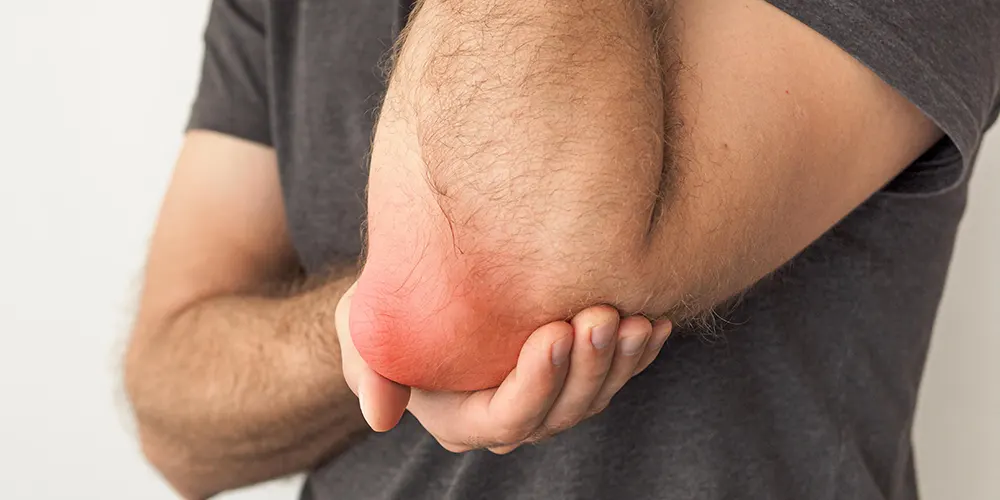When sharp, persistent pain around your joints starts limiting your daily activities—whether it’s climbing stairs, reaching overhead, or simply getting comfortable at night—you might be dealing with bursitis. But here’s what many people don’t realize: what’s often labeled as “bursitis” frequently involves much more than inflammation of those small fluid-filled sacs around your joints.
As board-certified acupuncturists specializing in musculoskeletal conditions, we’ve seen countless patients find relief through dry needling when other treatments have fallen short. Recent research has shown that dry needling can be just as effective as cortisone injections for treating bursitis-related pain, but with fewer side effects and better long-term outcomes.
In this comprehensive guide, we’ll explore how dry needling addresses not just the symptoms of bursitis, but the underlying muscular dysfunctions that often perpetuate this painful condition. You’ll discover why this evidence-based approach is gaining recognition among healthcare providers and how our specialized EXSTORE assessment system helps identify the true sources of your pain.
Understanding Bursitis: More Than Just Inflammation
Bursae are small, fluid-filled sacs strategically located throughout your body wherever tendons, muscles, or skin might rub against bones during movement. These structures act like tiny cushions, reducing friction and allowing smooth, pain-free motion at your joints. When functioning properly, you never even notice they’re there.
Bursitis occurs when these protective sacs become irritated, swollen, or inflamed. The most commonly affected areas include the greater trochanter (outer hip), the subacromial space (shoulder), the prepatellar and pes anserine regions (knee), and the olecranon (elbow). Each location presents unique challenges and requires specific treatment approaches.
However, here’s where conventional understanding often falls short: research increasingly shows that many cases diagnosed as “bursitis” don’t actually involve significant bursa inflammation. Instead, the pain and dysfunction stem from trigger points, muscle imbalances, and altered movement patterns in the surrounding musculature. Studies examining greater trochanteric pain syndrome—commonly called hip bursitis—have found that muscle tears, tendon strains, and trigger points can all cause pain in these areas without true bursa involvement.
This distinction matters enormously for treatment success. When we focus solely on reducing inflammation in the bursa itself, we may miss the underlying muscular dysfunctions that created the problem in the first place. Risk factors like repetitive movements, poor posture, muscle weakness, and biomechanical imbalances don’t just irritate bursae—they create chronic tension patterns that perpetuate pain even after acute inflammation subsides.
Understanding this broader picture is why we utilize comprehensive assessment techniques that look beyond the obvious pain points to identify all contributing factors.
The Science Behind Dry Needling for Bursitis
Dry needling works through multiple physiological mechanisms that directly address both the symptoms and underlying causes of bursitis-related pain. Unlike approaches that simply target inflammation, dry needling creates precise therapeutic responses at the cellular, muscular, and neurological levels.
When we insert fine needles into dysfunctional muscle tissue, several immediate changes occur. The mechanical disruption of trigger points—those hyperirritable knots within tight muscle fibers—releases accumulated tension and normalizes muscle fiber length. Research has demonstrated that successful trigger point needling produces measurable decreases in inflammatory substances like substance P and calcitonin gene-related peptide in the treated tissue, while simultaneously improving local blood flow and oxygenation.
The neurophysiological effects extend far beyond the needled area. Dry needling activates both peripheral and central pain-modulating pathways, effectively “resetting” sensitized pain receptors and reducing the hypervigilance that often develops with chronic bursitis. This explains why patients frequently experience immediate improvements in both pain levels and range of motion following treatment.
The trigger point model that guides our dry needling approach recognizes that muscles around affected joints often develop compensatory tension patterns. For instance, with shoulder pain, we frequently find trigger points in the upper trapezius, infraspinatus, and anterior deltoid that contribute to subacromial impingement and bursa irritation. Similarly, knee pain associated with pes anserine bursitis often involves dysfunction in the sartorius, gracilis, and semitendinosus muscles.
This comprehensive understanding allows us to address not just where you hurt, but why the pain developed and persists. By releasing these trigger points and normalizing muscle function, dry needling often provides lasting relief that extends well beyond the treatment session.
Our EXSTORE Approach to Bursitis Treatment
At our clinic, we utilize the EXSTORE system developed by Dr. Anthony Lombardi—a revolutionary approach that goes far beyond conventional bursitis assessment. This systematic method allows us to examine and restore proper muscle function, identifying the specific dysfunctions that contribute to your pain.
The examination phase involves comprehensive functional muscle testing that reveals which muscles are inhibited, overactive, or harboring trigger points. Unlike standard orthopedic tests that might only identify obvious pathology, EXSTORE assessment uncovers subtle imbalances that often perpetuate bursitis symptoms. We test muscle groups both individually and in their functional patterns, observing how they coordinate during movement.
For example, when evaluating suspected trochanteric bursitis, we don’t just assess the hip area. We examine the entire kinetic chain, including core stability, pelvic alignment, and even ankle function, since dysfunction anywhere along this chain can create compensatory stress at the hip. This might reveal that your “hip bursitis” actually stems from weakness in your deep hip stabilizers, causing other muscles to overwork and develop trigger points.
Once we’ve identified the specific dysfunctions, the restoration phase begins. Dry needling becomes one tool in a comprehensive treatment strategy. We target the precise trigger points and muscle imbalances discovered during assessment, often treating muscles that seem far removed from your pain but are actually key contributors to the problem.
The EXSTORE approach particularly excels in cases where previous treatments have provided only temporary relief. Traditional approaches might successfully reduce acute inflammation but fail to address the underlying muscle imbalances that caused the problem. Our systematic approach ensures we’re treating causes, not just symptoms.
We frequently combine dry needling with other targeted interventions based on assessment findings. This might include corrective exercise programming to address movement patterns, specific manual therapy techniques, or cupping treatments to enhance tissue mobility. The key is that every intervention is selected based on objective findings from your individual assessment.
This personalized approach explains why patients often experience improvements that extend beyond their original complaint. By restoring proper muscle function throughout the involved regions, we frequently see improvements in related areas that patients didn’t even realize were problematic.
What to Expect During Dry Needling Treatment
Your journey begins with a comprehensive two-hour initial consultation that sets the foundation for successful treatment. During this session, we conduct a complete orthopedic examination and EXSTORE assessment to fully understand your condition. This isn’t just about identifying where you hurt—we’re mapping out the complete picture of muscle imbalances, movement restrictions, and trigger points that contribute to your bursitis symptoms.
We’ll test your strength and range of motion systematically, looking for patterns that reveal the underlying causes of your pain. You’ll have the opportunity to ask questions about the treatment process and discuss how dry needling fits into your overall recovery plan. This thorough assessment ensures that when we begin treatment, every needle placement serves a specific therapeutic purpose.
During the actual dry needling procedure, you’ll feel minimal discomfort from the needle insertion itself—most patients describe it as a brief pinprick sensation. The therapeutic response occurs when we contact trigger points within the muscle tissue. You might experience a quick muscle twitch or brief cramping sensation, which indicates we’ve successfully accessed the dysfunctional tissue. This local twitch response, while momentarily intense, is actually a positive sign that the treatment is working.
Most patients require a series of treatments for optimal results. The exact number depends on several factors: how long you’ve had symptoms, the severity of muscle dysfunction, and your overall health status. For acute bursitis with recent onset, we might see significant improvement within 2-3 sessions. Chronic conditions that have developed over months or years typically require 4-6 treatments to achieve lasting change.
Between sessions, you’ll notice progressive improvements in both pain levels and function. Many patients experience some relief immediately after the first treatment, with continued improvement over the following days. We typically space treatments 7-10 days apart initially, allowing time for tissue healing and adaptation between sessions.
Some mild soreness in the treated muscles is normal for 24-48 hours after dry needling—similar to what you might feel after a vigorous workout. This post-treatment soreness actually indicates that positive changes are occurring in the muscle tissue. We’ll provide specific guidelines for managing any temporary discomfort and activities to avoid during the healing process.
Advantages of Dry Needling Over Traditional Treatments
When comparing treatment options for bursitis, dry needling offers several distinct advantages over conventional approaches. Most significantly, research demonstrates that dry needling provides equivalent pain relief and functional improvements to cortisone injections, but without the potential side effects and limitations associated with steroid use.
Cortisone injections, while often effective in the short term, carry risks including tissue weakening, infection, and systemic effects from steroid absorption. Additionally, repeated steroid injections can actually damage healthy tissue over time. Dry needling avoids these concerns entirely while achieving similar therapeutic outcomes through natural healing mechanisms.
Perhaps more importantly, dry needling addresses root causes rather than just managing symptoms. Anti-inflammatory medications and steroid injections focus primarily on reducing inflammation, but they don’t correct the muscle imbalances and trigger points that often perpetuate bursitis symptoms. This explains why many patients experience recurring episodes when using these conventional approaches alone.
Our dry needling treatments target the specific muscular dysfunctions that create abnormal stress on bursae. By normalizing muscle function and eliminating trigger points, we’re essentially removing the source of ongoing irritation. This approach often provides more sustainable relief because we’re fixing the underlying problem, not just masking the symptoms.
The precision of dry needling also allows us to treat multiple contributing factors simultaneously. During a single session, we can address trigger points in various muscles that all contribute to your bursitis symptoms. This comprehensive approach often produces faster, more complete recovery than treatments that focus on isolated structures.
For patients concerned about medication side effects or those who haven’t responded well to previous treatments, dry needling offers a safe, effective alternative. The technique integrates seamlessly with other therapeutic approaches, allowing us to create comprehensive treatment plans tailored to your specific needs and goals.
Conclusion
Bursitis doesn’t have to limit your life or force you to rely on repeated injections and medications for relief. Our evidence-based dry needling approach, enhanced by the comprehensive EXSTORE assessment system, addresses both the symptoms and underlying causes of your pain.
We’ve successfully helped countless patients overcome chronic bursitis symptoms that hadn’t responded to traditional treatments. By targeting the specific trigger points and muscle imbalances that contribute to bursa irritation, we’re able to provide lasting relief that allows you to return to the activities you love.
Whether you’re dealing with persistent hip pain that worsens when climbing stairs, shoulder discomfort that interrupts your sleep, or knee pain that limits your exercise routine, dry needling may be the solution you’ve been seeking. The technique is safe, effective, and backed by solid scientific research demonstrating its equivalence to more invasive treatments.Ready to take the next step toward lasting relief? Lycoming Orthopedic & Sports Acupuncture is here to help you overcome bursitis pain through our specialized dry needling services and comprehensive orthopedic acupuncture approach. Our experienced, board-certified practitioners will conduct a thorough assessment using the EXSTORE system to identify the specific causes of your pain and develop a personalized treatment plan. Don’t let bursitis symptoms control your life any longer—contact us today to schedule your comprehensive consultation and discover how dry needling can help you achieve lasting pain relief and improved function.





